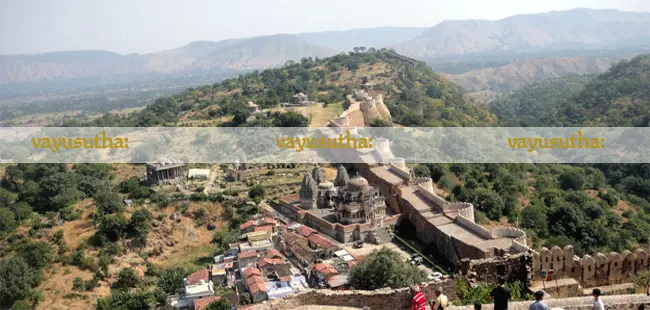
Mewar
The Mewar region is part of Rajasthan state now, but it includes some parts of Gujarat, Madhya Pradesh, and Haryana of present Bharat. The Mewar Kingdom is presently known as Udaipur Kingdom since its last capital was Udaipur. Lord Siva named Sri Medhpateshwar [Ekling Nath] the deity of the kingdom. The name Mewar was derived from the deity Medhpateshwar.
The Mewar region lies between the Aravali Range to the northwest, Ajmer to the north, Gujarat and the Vagad region of Rajasthan to the south, the Malwa region of Madhya Pradesh state to the southeast, and the Hadoti region of Rajasthan to the east.
This suggests that the region played a strategic role in allowing or forbidding the foreign invasion of Bharat.
Threat to Mewar
Ala-ud-din Khilji the second ruler of the Khilji dynasty and his Eunuch companion and army General Malik Kafur had held sanatana dharma of this land for ransom. Rajputs of Mewar who were ruling with Chittorgarh as the capital had also suffered at the hands of Khilji in the early fourteenth century. Alauddin Khalji's conquest of Mewar, Ranathambor, and Gujarat struck fear in the minds of the remaining Indian Kingdoms of Uttar Bharat.
Rana Kumbha of Mewar
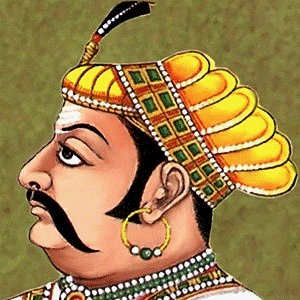 King of Mewar Maharana Mokal was assassinated by his two brothers (Chacha and Mera) in the year 1433. Lack of support, however, caused Chacha and Mera to flee. Rana Kumbha was the son of Rana Mokal by his wife Sobhagya Devi, daughter of Jaitmal Sankhla, the Parmara chief of Runkot in the state of Marwar.
King of Mewar Maharana Mokal was assassinated by his two brothers (Chacha and Mera) in the year 1433. Lack of support, however, caused Chacha and Mera to flee. Rana Kumbha was the son of Rana Mokal by his wife Sobhagya Devi, daughter of Jaitmal Sankhla, the Parmara chief of Runkot in the state of Marwar.
Rana Kumbha ascended the throne of Mewar. Initially, Rana Kumbha was ably assisted by Ranmal (Ranamalla) Rathore of Mandore. Mahmud Khilji, Sultan of Malwa was engaged in war with Rana Kumbha and was finally defeated by Rana Kumbha. In order to commemorate his resounding victory over the combined armies of Malwa and Gujarat in 1440 AD, Rana Kumbha got the famed 37 meters, 9-story high 'Vijay Sthambha' erected at Chittorgarh which was completed in 1448 AD.
While Man Singh Tomar of Madhya Bharat, Deva Raya II of Dhakshin Bharat, Kapilendradeva of Purvi Bharat, played an important part in preserving the Sanatana Dharma of Bharat, Mewar kingdom under the leadership of Rana Kumbha was the vanguard of the fifteenth century, for the resurgence of Sanatana Dharma in Uttarapaschima Bharat. A very tall and powerful personality, he held the Mewar flag flying high.
The deity of Sri Hanuman installed at the instance of a spiritual preceptor is spectacular. He is not only the guardian of the Kumbhalgarh fort, but also the Sanatana Dharma of Bharat. The very speciality of this deity is the war weapon which is held by Him in His left hand.
New Fort
Rana Kumbha was posed with the responsibility of defending his kingdom from the enemies’ Mahmud Khilji of Malwa, Qutbuddin of Gujrat, Shams Khan of Nagaur, and Rao Jodha of Marwar surrounding him. Therefore he built a new fort in a strategic location northwest of his capital. He selected the site of an old castle built by Samprati, a Jaina prince of the second century BC. The place is located 80 km northwest of Udaipur today and is known as Kumbhalgarh after his name. The fort was built by Rana Kumbha between 1443 and 1458 with able assistance of a famous architect Mandan.
Fort of Kumbhalgarh
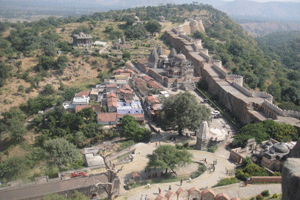 The fort is the highest in Rajasthan, 1075 meters above sea level, on an unassailable hill; this magnanimous structure is a saga of glory, gallant, and grandeur. The building of Kumbalgarh was done as per the ancient rules of Vastu Shastra. The sight of this magnificent bulbous fort seen while climbing is immemorable. Once on top one would feel as if the clouds are encompassing them. The view from the top of the fort will be even more wonderful. View of Marwar on one side and Mewar on the other side can be seen from this strategic location.
The fort is the highest in Rajasthan, 1075 meters above sea level, on an unassailable hill; this magnanimous structure is a saga of glory, gallant, and grandeur. The building of Kumbalgarh was done as per the ancient rules of Vastu Shastra. The sight of this magnificent bulbous fort seen while climbing is immemorable. Once on top one would feel as if the clouds are encompassing them. The view from the top of the fort will be even more wonderful. View of Marwar on one side and Mewar on the other side can be seen from this strategic location.
It is still a wonder as to how the materials had been lifted to build a fort at this height. Kumbhagarh fort was never won over and is known as the ‘unconquered fort’, Rana Kumbha an ‘undefeated king’. It had served as an impregnable hideout to the Mewar rulers during the crisis period.
The walls of the fort of Kumbhalgarh extend over 38 km and are fifteen feet thick. It is claimed to be the second-longest continuous wall after the Great Wall of China. It is said that both these structures can be seen from the images captured by the satellite. The Kumbhalgarh fort has seven fortified gateways.
Seven Gateways of the fort
The fort is entered from the south through a gate known as Aret Pol, followed by gateways known as Halla Pol, Hanuman Pol, Ram Pol, and Vijay Pol. The palatial complex at the top is approached further through three gateways viz., the Bhairon Pol, the Nimboo Pol, and the Paghra Pol. One more gateway is situated on the east which is known as Daniwatta. This gateway connects the Mewar region with Marwar.
Hanuman Pol [Hanuman Gate]
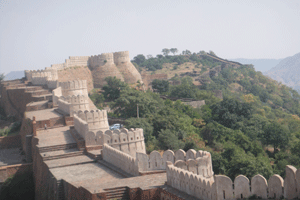 This Gate is built on the main wall of the fort and serves as the entry point to the entire complex. After that, there is a main Gate known as Ram Pol, through which one can get inside the complex. The Hanuman Pol is a significant gate for the Kumbhalgarh fort.
This Gate is built on the main wall of the fort and serves as the entry point to the entire complex. After that, there is a main Gate known as Ram Pol, through which one can get inside the complex. The Hanuman Pol is a significant gate for the Kumbhalgarh fort.
An interesting folklore is associated with this gate. When Rana Kumbh started the construction of this fort wall, the structure used to crumble. Whenever the work was started the same used to happen. Perplexed Rana approached a spiritual preceptor, who advised him to offer human sacrifice. He had instructed that it should be from a volunteer who is willing to help the kingdom.
When the word went out, for a few days no one came forward. On one fine day, a soldier volunteered to sacrifice his life for the sake of Mewar and to ensure that the walls of the fort being constructed by Rana Kumbha would be strong enough to withstand the sieges.
The main gate of the fort was constructed in the place where the great sacrifice had taken place. To commemorate the great sacrifice as per the wishes of the preceptor an image of Hanuman was enshrined near the gate.
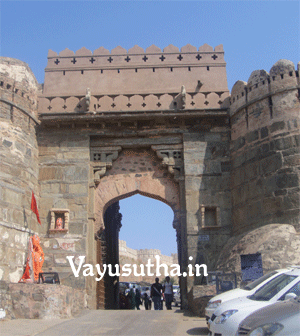 There are two Hanuman images in this gate. One is about twelve feet tall and the other is enshrined in a decorated window panel on the wall of the fort itself. Both idols of Sri Hanuman had been brought by Rana Kumbha from Mandavpur.
There are two Hanuman images in this gate. One is about twelve feet tall and the other is enshrined in a decorated window panel on the wall of the fort itself. Both idols of Sri Hanuman had been brought by Rana Kumbha from Mandavpur.
Sri Hanuman of Kumbhalgarh fort
The deity of Sri Hanuman installed at the instance of the spiritual preceptor is spectacular. He is not only the guardian of the Kumbhalgarh fort, but also the Sanatana Dharma of Bharat. The very speciality of this deity is the war weapon which is held by Him in His left hand. This weapon is not normally seen in the hands of Lord Hanuman. The weapon which goes by the name ‘kadvangam’ is seen in the hands of Lord Siva. Probably because the Mewar dynasty worships Ekling as their dynasty deity, Lord Hanuman also had been given this weapon here by Rana Kumbha.
Lord’s right hand is seen with the palm turned upward and holding something. In His both wrists Lord is wearing ‘Kakan’ [hollowed kada] and in His forearm, He is wearing Keyur. Both the ankles of Lord’s lotus feet are beautified by hollowed anklets and nupur.
The tail of the Lord [incidentally it is also a weapon of the Lord Hanuman] is so long that it goes upward and goes behind His head and falls through on the left side. There is a great long garland made of Rudraksha falling from the right shoulder up to the ankle turns leftward and goes behind the Lord. Just below the left feet of the Lord, a demon is held to the ground, the pressure applied on the demon can be estimated by the size and shape of the left calf muscle of the Lord. Despite all this, the calm posture is seen in the Lord's face. His eyes are radiating calmness to the devotee. This description of Lord Hanuman’s Deity is not seen anywhere else in this Land.
Location of the temple: Sri Hanuman Pol, Kumbhalgarh"
Experience
Have the darshan of Lord Hanuman holding ‘kadvangam’, and face any situation in any difficult terrain with determination to achieve the ‘unconquerable’ position in life.
SRI HANUMAN THINKS DIFFERENTLY, THINKS FAST
THINKS AHEAD AND ACTS FOR SURE
Ed [Nov 2015]
Updates: [Jan 2025]
